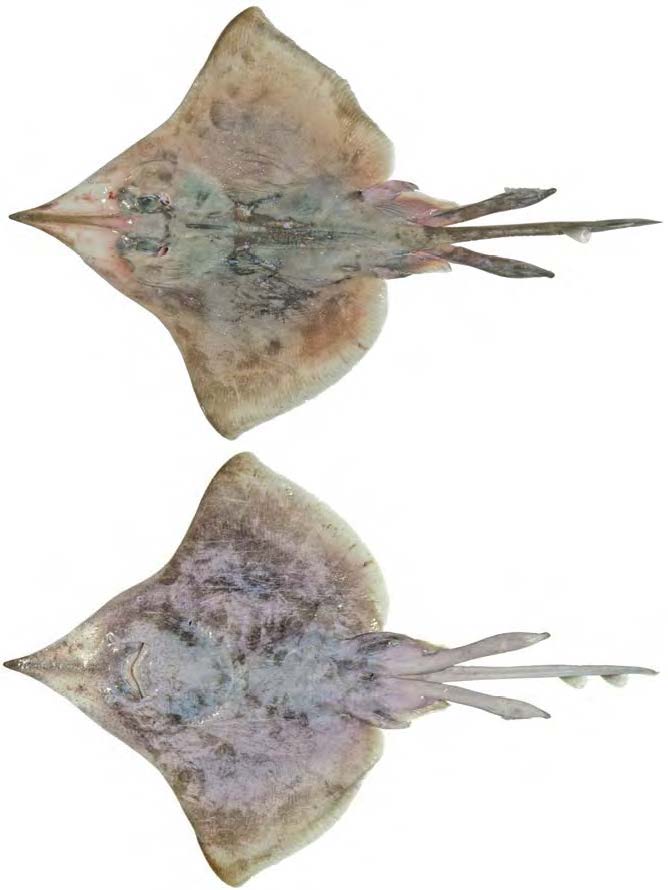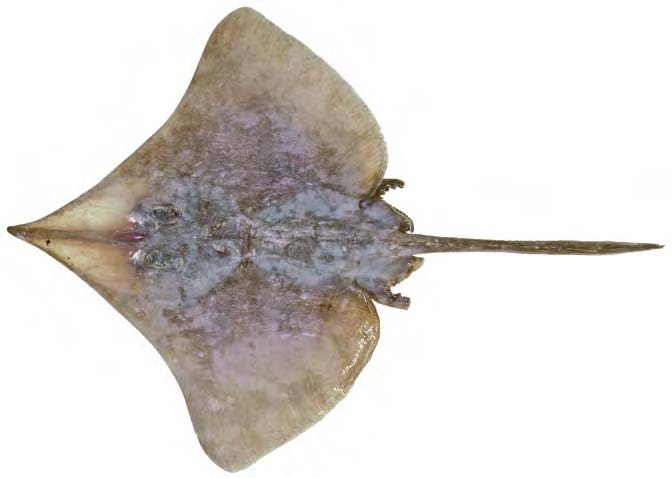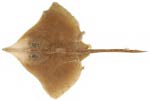Dipturus apricus
Last, White & Pogonoski, 2008
Pale tropical skate
Classification: Elasmobranchii Rajiformes Rajidae
Reference of the original description
New skates of the genus Dipturus (Rajoidei: Rajidae) from Australian Seas. CSIRO Marine and Atmospheric Research Paper, 21, 9–52
New skates of the genus Dipturus (Rajoidei: Rajidae) from Australian Seas. CSIRO Marine and Atmospheric Research Paper, 21, 9–52
Image of the original description

Dipturus apricus sp. nov, adult male holotype (CSIRO H 601–01, 598 mm TL, fresh): A, dorsal surface; B, ventral surface..; In: Last, P.R. & White, W.T. & Pogonoski, J.J. 2008 New skates of the genus Dipturus (Rajoidei: Rajidae) from Australian Seas. CSIRO Marine and Atmospheric Research Paper, 21: 9-52

Dipturus apricus sp. nov, adult male holotype (CSIRO H 601–01, 598 mm TL, fresh): A, dorsal surface; B, ventral surface..; In: Last, P.R. & White, W.T. & Pogonoski, J.J. 2008 New skates of the genus Dipturus (Rajoidei: Rajidae) from Australian Seas. CSIRO Marine and Atmospheric Research Paper, 21: 9-52
Types
Dipturus apricus
Holotype: CSIRO: H 601-01; Paratype: AMS: I.25808-022; AMS: I.25800-047; AMS: I.25809-013; CSIRO: H 3643-12; CSIRO: H 947-14; CSIRO: H 1113-09; CSIRO: H 1114-02; CSIRO: H 718-25; CSIRO: H 715-03; CSIRO: H 692-02; CSIRO: H 692-04; CSIRO: H 692-01; CSIRO: H 617-09; CSIRO: H 600-03; CSIRO: H 699-02; CSIRO: H 692-05; CSIRO: H 692-06; CSIRO: H 617-10; CSIRO: H 626-04; NMV: A 29737-001; NMV: A 29737-002; QM: I 19317; QM: I 19320;
Dipturus apricus
Holotype: CSIRO: H 601-01; Paratype: AMS: I.25808-022; AMS: I.25800-047; AMS: I.25809-013; CSIRO: H 3643-12; CSIRO: H 947-14; CSIRO: H 1113-09; CSIRO: H 1114-02; CSIRO: H 718-25; CSIRO: H 715-03; CSIRO: H 692-02; CSIRO: H 692-04; CSIRO: H 692-01; CSIRO: H 617-09; CSIRO: H 600-03; CSIRO: H 699-02; CSIRO: H 692-05; CSIRO: H 692-06; CSIRO: H 617-10; CSIRO: H 626-04; NMV: A 29737-001; NMV: A 29737-002; QM: I 19317; QM: I 19320;
Description :
Citation: Dipturus apricus Last, White & Pogonoski, 2008: In: Database of modern sharks, rays and chimaeras, www.shark-references.com, World Wide Web electronic publication, Version 01/2026
Please send your images of "Dipturus apricus" to info@shark-references.com

Dorsal surface of Dipturus apricus sp. nov. female paratype (CSIRO H 947–14, 449 mm TL, fresh); In: Last, P.R. & White, W.T. & Pogonoski, J.J. 2008 New skates of the genus Dipturus (Rajoidei: Rajidae) from Australian Seas. CSIRO Marine and Atmospheric Research Paper, 21: 9-52

Dorsal surface of Dipturus apricus sp. nov. female paratype (CSIRO H 947–14, 449 mm TL, fresh); In: Last, P.R. & White, W.T. & Pogonoski, J.J. 2008 New skates of the genus Dipturus (Rajoidei: Rajidae) from Australian Seas. CSIRO Marine and Atmospheric Research Paper, 21: 9-52
Common names
 Pale tropical skate
Pale tropical skate
 Pale tropical skate
Pale tropical skate
Short Description
Original diagnosis of LAST, WHITE & POGONOSKI, 2008 [3309]: A medium-sized species of Dipturus (to 76.5 cm TL) with the following combination of characters: disc relatively broad with angular apices, width 67–71% TL, 1.1–1.2 times its length; snout angle 68–77°; tail length 0.7–0.8 in distance from snout tip to rear of cloaca; tail relatively slender, width 1.4–1.7 times height at its midlength, 1.4–1.8 times at first dorsal-fin origin; pre-upper jaw length 18–22% TL, 2.4–2.8 times internasal width; ventral head length 33–36% TL; snout length 4.1–4.8 times interorbital width; orbit diameter 52–72% interorbital width; first dorsal-fin height 1.8–2.4 in its base length; distance from first dorsal-fin origin to tail tip 2.9–3.6 times first dorsal-fin base length, 3.0–3.9 times caudal-fin length; pelvic fins of medium size, length of posterior lobe of adult males 15–17% TL, length of anterior lobe 67–69% of posterior lobe; adult clasper relatively short, 23–27% TL, connected to pelvic-fin inner margin at about 36–41% of its length from cloaca; anterior margins of both surfaces of disc with narrow bands of fine denticles in late adolescent and adult males; no nuchal or malar thorns; tail with a single thorn row in males, 1–2 additional pairs of variably developed lateral rows in largest females; total pectoral radials 86–91; trunk centra 28–31; predorsal centra 75–83; total centra about 128–140; tooth rows in upper jaw 32–40; mainly uniformly greyish brown dorsally; mostly darker greyish brownish (blotchy) ventrally, snout tip usually blackish; ventral sensory pores small, distinct, black-edged, not surrounded by greyish blotches.
Original diagnosis of LAST, WHITE & POGONOSKI, 2008 [3309]: A medium-sized species of Dipturus (to 76.5 cm TL) with the following combination of characters: disc relatively broad with angular apices, width 67–71% TL, 1.1–1.2 times its length; snout angle 68–77°; tail length 0.7–0.8 in distance from snout tip to rear of cloaca; tail relatively slender, width 1.4–1.7 times height at its midlength, 1.4–1.8 times at first dorsal-fin origin; pre-upper jaw length 18–22% TL, 2.4–2.8 times internasal width; ventral head length 33–36% TL; snout length 4.1–4.8 times interorbital width; orbit diameter 52–72% interorbital width; first dorsal-fin height 1.8–2.4 in its base length; distance from first dorsal-fin origin to tail tip 2.9–3.6 times first dorsal-fin base length, 3.0–3.9 times caudal-fin length; pelvic fins of medium size, length of posterior lobe of adult males 15–17% TL, length of anterior lobe 67–69% of posterior lobe; adult clasper relatively short, 23–27% TL, connected to pelvic-fin inner margin at about 36–41% of its length from cloaca; anterior margins of both surfaces of disc with narrow bands of fine denticles in late adolescent and adult males; no nuchal or malar thorns; tail with a single thorn row in males, 1–2 additional pairs of variably developed lateral rows in largest females; total pectoral radials 86–91; trunk centra 28–31; predorsal centra 75–83; total centra about 128–140; tooth rows in upper jaw 32–40; mainly uniformly greyish brown dorsally; mostly darker greyish brownish (blotchy) ventrally, snout tip usually blackish; ventral sensory pores small, distinct, black-edged, not surrounded by greyish blotches.
Remarks
shark-references Species-ID=1978;
shark-references Species-ID=1978;

















